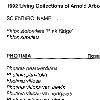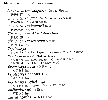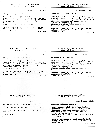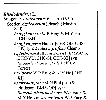BG-BASE produces a wide range of outputs including:
Data can also be output for use by GIS (Geographic Information
Systems) and other mapping systems, such as BG-Map.
Reports
Many reports in BG-BASE (generated by the S/LIST Report
Builder) are columnar reports, in which each column represents one field.
Each database table has a default report that combines many of the most
important fields in that table; you can over-ride these default reports by
specifying one or more fields in the order in which you wish to see them
displayed. Thus
LIST ACCESSIONS
will display the default report for the ACCESSIONS table, but
LIST ACCESSIONS ACC_DT NAME
will display three columns: accession number (the record key for a
table is always displayed unless specifically suppressed), accession date, and
the name of the accession.
Display widths can be altered on the fly, and text longer than
the chosen width can word-wrap to the next line; thus, no data need be
truncated on a report. All reports can be sorted by as many fields as necessary
(using a combination of ascending and descending sorts), and records to be
displayed can be selected by combining as many selection criteria as
necessary; these selection criteria can be joined with either a logical AND or
a logical OR; for example:
SELECT CONTACTS WITH W_CITY = "SAN FRANCISCO" AND WITH FAMILY_EXPERT = "ORCHIDACEAE"
SELECT CONTACTS WITH W_CITY = "SAN FRANCISCO" OR WITH FAMILY_EXPERT = "ORCHIDACEAE"
SELECT ACCESSIONS WITH GENUS = "IRIS" AND WITH
ACC_DT > "1 JAN 1994"
Herbaruim labels
Herbarium (or other preserved specimen) labels can be complex,
with many parameters. Each herbarium label format definition is stored as a
record in the BG-BASE LABEL_FORMATS table. These records have fields for
the paper size, margin, typeface, headers, footers, and so on. For each field
chosen to show on the label, the following characteristics can be controlled:
- format
- justification
- maximum length
- bold
- italics
- underlined
- first letter capitalized
- suppress field (if null)
- relative position
- relative point size
- brackets to surround the field (parentheses, square brackets, angle brackets, etc.)
- multivalue separator (comma, period, slash, etc.)
- terminator
- gap (between adjacent fields, and
- continuation flag to join adjacent fields
Once the label format has been set up, all herbarium labels
attached to a particular format have the identical structure.
Herbarium labels can be sent to the screen, to a printer or to a
text file, and they can be generated for a single record or in batch mode for
many records. Using the appropriate selection criteria, you can output either
some or all records from the SPECIMENS table.
Herbarium labels may also be created externally by exporting the data as text files and then using the merge
capabilities found in other software such as Word, WordPerfect, Excel, etc.
Engraved Labels
BG-BASE can be used to export text files that can then be
used by various engravers; the majority of BG-BASE sites use New
Hermes machines, but other engraving devices can be used as well, as long
as those engravers can import text files into their own software programs.
These engraved labels are relatively long-lasting and can be formatted in a
variety of ways.
Embossed Labels
BG-BASE has output routines written for Datacard, Norcom, and Addressograph embossing machines; other embossing devices
can also be supported if required. These embossed labels are very long-lasting
and come in a variety of sizes, shapes, and colors, making them ideal for
permanent curatorial labels. Embossed labels are usually produced from the
ACCESSIONS or PLANTS tables. .
Barcode labels
BG-BASE can produce barcodes directly from several tables
(ACCESSIONS, PLANTS, PROPAGATIONS, GERMPLASM, DATA SOURCES, IMAGES, SPECIMENS),
or pre-printed barcodes can be applied (as is often done in herbaria). Hand-held devices can be used to read these
barcodes into the system. To date, BG-BASE sites producing their own
barcode labels are doing so using Zebra 105S printers using ZPL II (Zebra Programming Language II). Contact BG-BASE, Inc. for further
information.
Camera-ready PCL output
Output routines for PCL (Printer Control Language), version 3 or
above, the native language of all Hewlett Packard LaserJets, have been written
for several special reports in BG-BASE. Publications such as the Arnold
Arboretum's Inventory of Living
Collections, the Royal Botanic Garden Edinburgh's Catalogue of Plants 1995 and the
World Conservation Monitoring Centre's 1997
IUCN Red List of Threatened Plants have been generated directly from BG-BASE in this manner. These output routines take total control of the
font, the font size, and the placement of text on the page and can also
generate indexes as the main body is exported. The advantage of this over RTF
output (see below) is that only one step is involved - BG-BASE produces
camera-ready copy directly. The disadvantage is that each new report needs a
new program to be written (thus, this is less efficient for one-off outputs or
for outputs whose formats need to change regularly).
RTF Output
Output routines for producing RTF (Rich Text Format) have been
written for several special reports in BG-BASE. Publications such as the
New England Wildflower Society's Flora
Conservanda, the Royal Botanic Garden's The genus
Rhododendron. Its classification
and synonymy, the Royal Botanic Garden
Edinburgh's Catalogue of Plants 2001 and the
Royal Horticultural Society's The RHS Plant
Finder have been
produced using RTF output generated by BG-BASE. The advantage of RTF
output over PCL output (see above) is that RTF allows you to fine-tune the
placement of the text on a page, using any modern word processor or a desk top
publishing application. The disadvantage is that there is an extra step
compared to PCL output - the output file must be run through another
application.
HTML output for the Worldwide Web (WWW)
Martin Pullan of the Royal Botanic Garden Edinburgh has produced a
general-purpose program that will allow any Advanced Revelation or OpenInsight application, such as BG-BASE, to output data from the
database directly as fully indexed, searchable HTML documents. You can control
which fields are exported, what indexes are linked to each field, and how the
fields appear on the Web page; in addition, you can select all or only some of
the records in a particular database table to export. These parameters are
stored as export templates. Records from several different tables can be
exported as part of an export session (whose parameters are also
controlled by this program). The HTML output files contain all selected records
and fields as well as file offsets to each indexed word, so that the output
files can be queried directly and immediately by a CGI script. The living
collections information on the home pages of the Royal Botanic Garden Edinburgh and the Royal Horticultural Society was exported in
this fashion.
Visit the multisite search page to search in collections around the world. The data available from this
page are extracted from the on-line Living Collections and conservation
databases at BG-BASE sites.
ITF output
BG-BASE was the first database designed specifically to
follow the ITF (International
Transfer Format for Botanic Garden Records) and remains compatible with
the ITF, although it vastly expands upon the 33 fields that comprise ITF
version 1. Records can be exported from BG-BASE in ITF (version 1)
format using the ITF program.
Examples of outputs from BG-BASE
| Simple
output (standard reports) |
 |
Inventory report from one bed code at the Holden Arboretum procuded by the INVENTORY tool in BG-BASE (click image to see enlargement) |
|
|
| PCL output (direct-to-page) |
 |
Arnold Arboretum's Inventory of Living
Collections; produced as camera-ready copy using PCL (click image to
see enlargement) |
 |
Royal Botanic Garden Edinburgh's 1995
Catalogue of Plants; produced as camera-ready copy using PCL (click
image to see enlargement) |
 |
World Conservation Monitoring Centre's 1997 IUCN Red List of Threatened Plants; produced as camera-ready
copy using PCL (click image to see enlargement) |
|
|
 |
example of 6 herbarium specimen labels per A4
page, showing variable-size labels and crop marks; produced as camera-ready
copy using PCL (click image to see enlargement) |
 |
example of herbarium label on a sheet;
produced as camera-ready copy using PCL (click image to see enlargement) |
| RTF output |
 |
Royal Horticultural Society's RHS Plant
Finder 1997-98; produced as RTF output (click image to see
enlargement) |
 |
Royal Botanic Garden Edinburgh's The
genus Rhododendron; produced via RTF output (click image to see
enlargement) |
| HTML output |
 |
searchable database of all CITES-listed
plants released by the World Conservation Monitoring Centre (click image to
go to the live
dataset) |
 |
searchable database of the living collections
in the Royal Botanic Garden Edinburgh (click image to go to the live
dataset) |
 |
searchable database of the living collections
of the Arnold Arboretum (click image to go to the live dataset) |
 |
searchable database of the preserved collections
at the University of Connecticut (click image to go to the live dataset) |
|